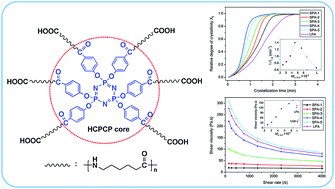Synthesis and properties of star-branched nylon 6 with hexafunctional cyclotriphosphazene core†
Abstract
A novel star-branched nylon 6 with hexafunctional cyclotriphosphazene core was synthesized using hexa(4-carboxylphenoxy)cyclotriphosphazene (HCPCP) with six carboxyl groups as multifunctional agent in the hydrolytic ring-opening polymerization of ε-caprolactam, and then used for the investigation of mechanical properties, crystallization and rheology behaviors. Star-branching structure and molecular weight have great effects on its properties. Compared with linear nylon 6, star-branched nylon 6 has lower relative viscosity and higher melt flow rate while its mechanical properties can be almost retained by the use of star-branching and an appropriate molecular weight. Research on crystallization behavior indicates that the degree of crystallinity (Xc) of star-branched nylon 6 decreases slightly, but its crystal structure still belongs to α form. The peak crystallization temperature (Tc) and crystallization rate (1/t1/2) of star-branched nylon 6 are significantly higher than that of linear nylon 6 because of heterogeneous nucleation induced by HCPCP core, which is beneficial for the use of rapid molding process. As the molecular weight increases, the Tc and 1/t1/2 of star-branched nylon 6 first increase and then decrease. Capillary rheometer measurement exhibits that the shear viscosity of star-branched nylon 6 decreases with decreasing molecular weight, and the shear viscosity of star-branched nylon 6 with an appropriate molecular weight shows a low value and little or no sensitivity to shear rate and temperature. Such rheology behavior allows for processing at low temperature and low pressure and reduces system cost.


 Please wait while we load your content...
Please wait while we load your content...